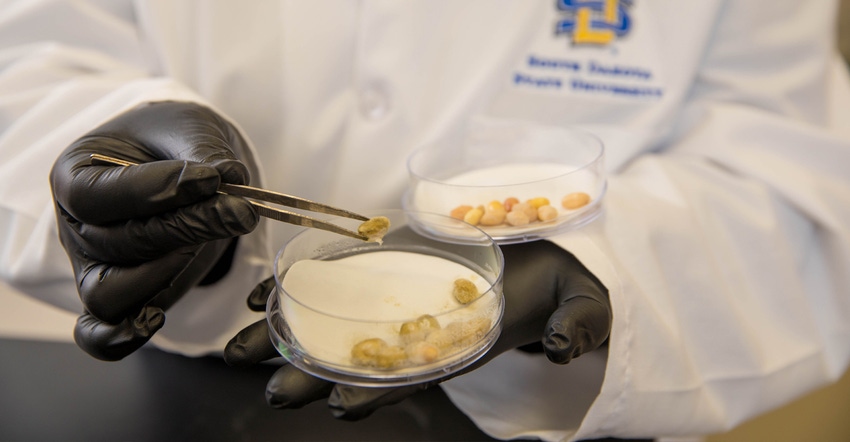December 16, 2021

South Dakota State University scientists are researching ways to help animals stay healthy using an antimicrobial compound produced by soybean plants. This compound is produced by plants when threatened by insects, which can reduce the need for antibiotics.
“When a soybean is attacked by a pathogen, the plant produces phytochemicals called glyceollins as a defense mechanism,” says assistant professor Bishnu Karki of biotechnology and bioprocessing at South Dakota State University.
Her research group has identified pathogens and lab-scale processes to trigger production of glyceollins and has begun assessing soybean varieties to see which produce higher levels of the antimicrobial compounds.
“Animals such as pigs and poultry already consume diets high in soybeans and could benefit from the phytochemical’s antimicrobial properties,” says Karki, adding that scientists are studying the impact of glyceollins on human health, specifically in relation to cancer, inflammation and cardiovascular diseases.
Karki’s research is supported by USDA Hatch Act funding through the South Dakota Agricultural Experiment Station. Two master’s students and several undergraduates have also worked on the project.
In the past, antibiotics were integrated into animal feed and water to help animals stay healthy and reach market weight efficiently. However, the Food and Drug Administration’s Veterinary Feed Directive, which seeks to decrease the development of antibiotic-resistance microorganisms, recently limited the use of antibiotics to specific health problems. Therefore, livestock producers are in need of natural alternatives, such as glyceollin-enriched soybeans, that can provide benefits similar to those of antibiotics.
Producing glyceollins
Under normal conditions, glyceollins are not present in soybeans, Karki says. When soybeans are threatened by environmental stressors, such as a fungal infection, the plant responds by making glyceollins to defend itself.
Karki and her team worked with research chemist Mark Berhow of the functional foods group at the USDA Agricultural Research Service in Peoria, Ill., to determine how to maximize glyceollins production in soybeans. The goal was to produce at least 3 milligrams of glyceollins per gram of soybeans, the amount needed for use as an antimicrobial in swine feed.
The researchers found dehulled, sprouted soybeans inoculated with fungi produced higher glyceollin levels than beans in the hull or halved. The soybeans are then freeze-dried and ground to determine glyceollin levels. Results, published in the Mycological Progress journal, showed the capacity to produce 3.763 mg of glyceollins per gram of soybeans.
In a subsequent study, the researchers evaluated about a dozen soybean varieties, inoculating them with two varieties of edible fungus and incubating them for up to 120 hours. They found that the fungus, Aspergillus sojae, elicited better production of glyceollins with levels peaking from 96 to 120 hours incubation.
In addition, Karki says the soybean variety makes a difference. Although a variety’s susceptibility to fungal diseases did not boost production, the early-maturing varieties tended to produce more glyceollins, and exposure to ultraviolet light before fungal inoculation improved those results.
The next step will be to test more varieties from different states to identify those with higher potential for producing glyceollins and then work with breeders to examine the genetic pathways through which this occurs.
Going to next level
“We have a lab-scale process, but we need to scale it up to show its feasibility,” Karki says, noting that testing to make sure the process was repeatable involved up to 100 beans. The new Poet Bioproducts Institute in the Research Park at SDSU will play an integral role in scaling up this technology. The facility should be completed by summer 2023.
“The use of naturally occurring compounds to replace antibiotics could be a game changer in the animal production industry,” says distinguished professor Bill Gibbons, associate dean of research for the College of Agriculture, Food and Environmental Sciences and director of the South Dakota Agricultural Experiment Station. “Through the Poet Bioproducts Institute, researchers can collaborate with industry partners to bring promising bioprocessing technologies such as this to the marketplace.”
“Production of glyceollins is better when soybeans are dehulled, but we need to keep the endosperm intact for seed to germinate,” Karki says. “Commercial dehulling equipment can crack the soybeans, so we need to custom-design a machine that can remove the hulls without disrupting the endosperm.”
Furthermore, understanding the metabolic pathways through which soybeans divert energy toward producing glyceollins will help scientists manipulate those pathways to increase production of the antimicrobial compound.
“Soybeans are one of the largest commodities in the animal and human nutrition market,” Karki says. If soybeans rich in glyceollins can provide health benefits to animals, they may also have the potential to improve human health, she adds.
Source: SDSU, which is responsible for the information provided and is wholly owned by the source. Informa Business Media and its subsidiaries aren't responsible for any of the content contained in this information asset.
You May Also Like




